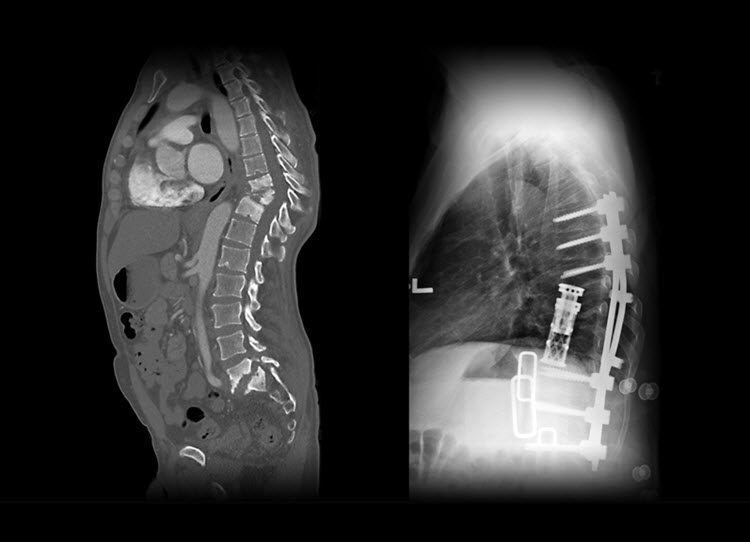Costotransversectomy: An alternative surgical approach to challenging thoracic spine reconstructions
While open thoracotomy is the traditional approach most often chosen for patients undergoing thoracic spine reconstruction, alternative approaches can be useful in certain situations. Mark Knaub, MD, Penn State Bone and Joint Institute, says, “For patients with spinal tumors, osteomyelitis or major trauma, particularly at upper thoracic levels, an open thoracotomy may not offer sufficient access to the surgical site. In these cases, a costotransversectomy approach can be superior. A single surgical approach can be used for both removal of diseased vertebral body tissue and placement of stabilizing hardware.” To minimize complications and optimize reconstruction, Knaub explains, “It’s critical to achieve the proper angle of access and for this it’s necessary to remove approximately five centimeters or more of at least two ribs; in some situations, more rib tissue must be removed. Such removal also involves sacrificing one or two thoracic nerve roots.” Because the nerve roots are sensory in nature and share overlapping fields of innervation, patients may experience postoperative numbness, but there are no functional consequences. There is a small risk of violation of the pleura, as well as major blood vessel injury. These risks can be minimized by staying right against the bone while working in the anterior column.

Male, 42 years old, presented with progressive lower extremity paralysis after being treated non-operatively for multi-level thoracic discitis and osteomyelitis. A costotransversectomy was utilized to perform a four level corpectomy, anterior reconstruction with an expandable cage, and posterior stabilization. The patient’s paralysis has resolved and he has no signs of ongoing infection.
Costotransversectomy also poses a slightly higher risk of spinal cord injury. Knaub explains, “With a costotransversectomy approach, unlike with open thoracotomy, the spinal cord is typically circumferentially exposed, increasing the risk of injury. In many patients, it is impossible to see the anterior portion of the dura during surgery. This also increases the chance of spinal cord injury.” Recent improvements in vertebral body replacement devices have helped to ease the reconstructive portion of these procedures. Knaub comments, “At Milton S. Hershey Medical Center we use expandable interbody cages for anterior vertebral reconstruction and stabilization. These are inserted in a collapsed position, making it easier to maneuver past the spinal cord. We then position and open it to the needed size. Overall, it’s safer and results in a better anterior column reconstruction.” In Knaub’s experience, patients typically have an easier postoperative recovery following costotransversectomy, compared to open thoracotomy.
“A costotransversectomy approach involves a single surgical site and doesn’t require placement of a chest tube. In my experience, patients have less pain and are able to ambulate sooner. We also see a decrease in pulmonary complications. Without a chest tube, it’s also easier to place a brace for postoperative stabilization in patients who’ve undergone multilevel reconstruction.”

Mark A. Knaub, MD
Orthopaedic Spine Surgeon
Associate Director, Penn State Spine Center
Assistant Professor, Orthopaedics and Rehabilitation
Phone: 717-531-4837
Email: mknaub@pennstatehealth.psu.edu
Fellowship: Spine surgery, William Beaumont Hospital, Royal Oak, Mich.
Residency: Orthopaedic surgery, University of Pittsburgh Medical Center, Pittsburgh, Pa.
Medical School: University of Pittsburgh School of Medicine, Pittsburgh, Pa.
Connect with Mark A. Knaub, MD, on Doximity
